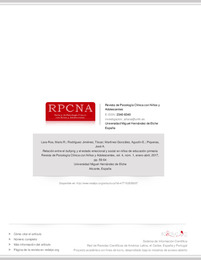Please use this identifier to cite or link to this item:
https://hdl.handle.net/11000/35990Full metadata record
| DC Field | Value | Language |
|---|---|---|
| dc.contributor.author | Lara-Ros, Mario R. | - |
| dc.contributor.author | Rodríguez-Jiménez, Tíscar | - |
| dc.contributor.author | MARTINEZ-GONZALEZ, AGUSTIN ERNESTO | - |
| dc.contributor.author | Piqueras, Jose A | - |
| dc.contributor.other | Departamentos de la UMH::Psicología de la Salud | es_ES |
| dc.date.accessioned | 2025-03-14T11:55:25Z | - |
| dc.date.available | 2025-03-14T11:55:25Z | - |
| dc.date.created | 2017-01 | - |
| dc.identifier.citation | Revista de Psicología Clínica con Niños y Adolescentes, Vol. 4. Nº. 1 - Enero 2017 - pp 59-64 | es_ES |
| dc.identifier.issn | 2340-8340 | - |
| dc.identifier.uri | https://hdl.handle.net/11000/35990 | - |
| dc.description.abstract | El bullying o acoso escolar entre iguales tiene una elevada prevalencia, manifestándose cada vez a edades más tempranas. El objetivo de este tra- bajo fue examinar la relación entre el bullying, el estatus social y la sintomatología ansiosa y depresiva en niños de 9 a 12 años. La muestra estuvo formada por niños pertenecientes a 10 aulas de cuarto a sexto curso de Educación Primaria. Se empleó el Test de Evaluación de la Agresividad entre Escolares (Bull-S) para examinar los perfiles de bullying y el estatus social de los niños, y la versión de 30 ítems de la Escala Revisada de Ansiedad y Depresión Infantil (RCADS-30) para evaluar síntomas emocionales. Los resultados revelaron que el 17.70% de los alumnos estaba directamente implicado en situaciones de bullying. Además se encontraron diferencias significativas en cuanto a las características de los perfiles de observadores u otros, agresores o acosadores, víctimas y víctimas-agresoras. Así, las víctimas presentaron mayores niveles de sintomatología ansiosa y depresiva, específicamente ansiedad por separación y depresión mayor. Estas puntuaciones fueron especialmente marcadas en las chicas respecto de los chicos. En cuanto al estatus social los sujetos agresores muestran puntuaciones significativamente mayores en las variables rechazo y expectativa de rechazo comparativamente con los sujetos observadores e, incluso, los sujetos víctimas. Estos datos señalan la necesidad de considerar el estatus sociométrico y la sintomatología emocional asociada a los diferentes roles del bullying en el diseño de programas de prevención escolar y la conve- niencia del análisis de estas dinámicas desde la Educación Primaria. | es_ES |
| dc.description.abstract | Relationship between bullying and emotional and social status among primary scholars. Bullying has a high prevalence and its presence is increasing in the young population. The objective of this study is to examine the relationship between bullying, social status, and the anxiety and depression symptoms in children aged 9 to 12. The sample consisted of children from 10 classrooms of fourth to sixth grade level from primary schools. We assess aggressiveness among students (Bull-S Test) to examine the bullying profiles, the social status of children, and the 30-item version of the Revised Child Anxiety and Depression Scale (RCADS-30) to assess emotional symptoms. The results revealed that 17.70% of the students were directly involved in bullying situations. Additionally, we found significant differences concerning the characteristics of the profiles of observers or others, bullies, victims, and bullies-victims. Thus, the victims presented higher levels of anxious and depressive symptoms, specifically separation anxiety and major depression. These scores were especially noteworthy for girls. Regarding social status, bullies show scores significantly higher in rejection and expectation of rejection compared to the observers and victims. These data indicate the need to consider the sociometric status and emotional symptomatology associated to the different roles of bullying in the design of school prevention programs and the convenience of the analysis of these dynamics from the early stage of primary school. | es_ES |
| dc.format | application/pdf | es_ES |
| dc.format.extent | 7 | es_ES |
| dc.language.iso | spa | es_ES |
| dc.publisher | Universidad Miguel Hernández de Elche | es_ES |
| dc.rights | info:eu-repo/semantics/openAccess | es_ES |
| dc.rights | Attribution-NonCommercial-NoDerivatives 4.0 Internacional | * |
| dc.rights.uri | http://creativecommons.org/licenses/by-nc-nd/4.0/ | * |
| dc.subject | acoso escolar | es_ES |
| dc.subject | estatus social | es_ES |
| dc.subject | ansiedad | es_ES |
| dc.subject | depresión | es_ES |
| dc.subject | niños | es_ES |
| dc.subject | bullying | es_ES |
| dc.subject | social status | es_ES |
| dc.subject | anxiety | es_ES |
| dc.subject | depression | es_ES |
| dc.subject | children | es_ES |
| dc.subject.other | CDU::1 - Filosofía y psicología::159.9 - Psicología | es_ES |
| dc.title | Relación entre el bullying y el estado emocional y social en niños de educación primaria | es_ES |
| dc.type | info:eu-repo/semantics/article | es_ES |

View/Open:
2017_76_Investigacion_Publicaciones_Relacion entre el bullying.pdf
143,86 kB
Adobe PDF
Share:
.png)
